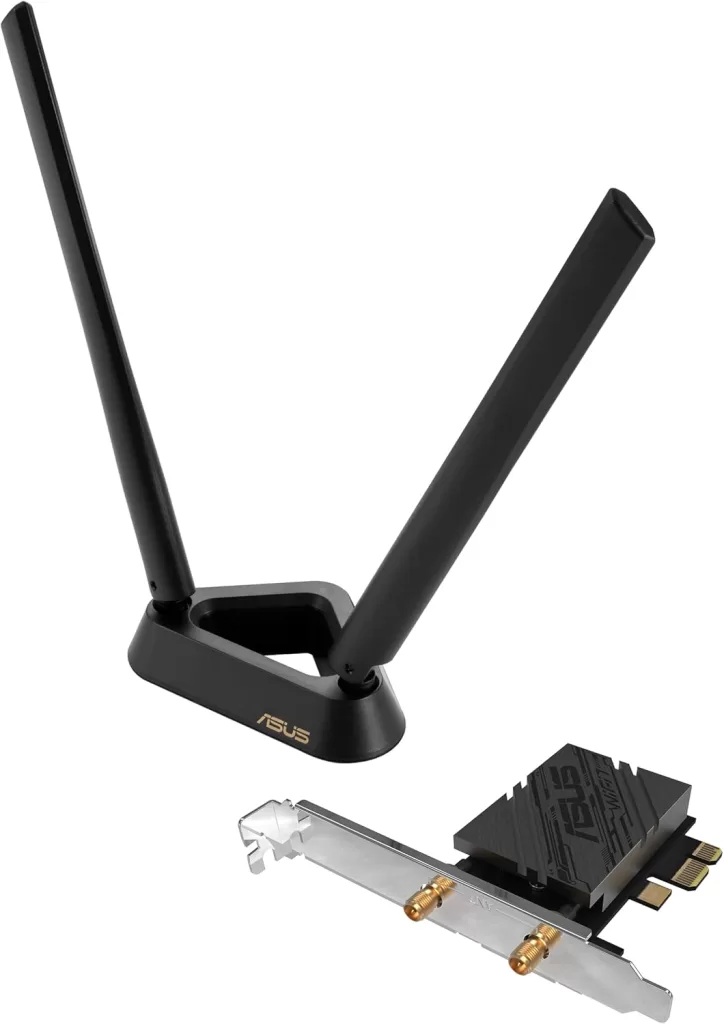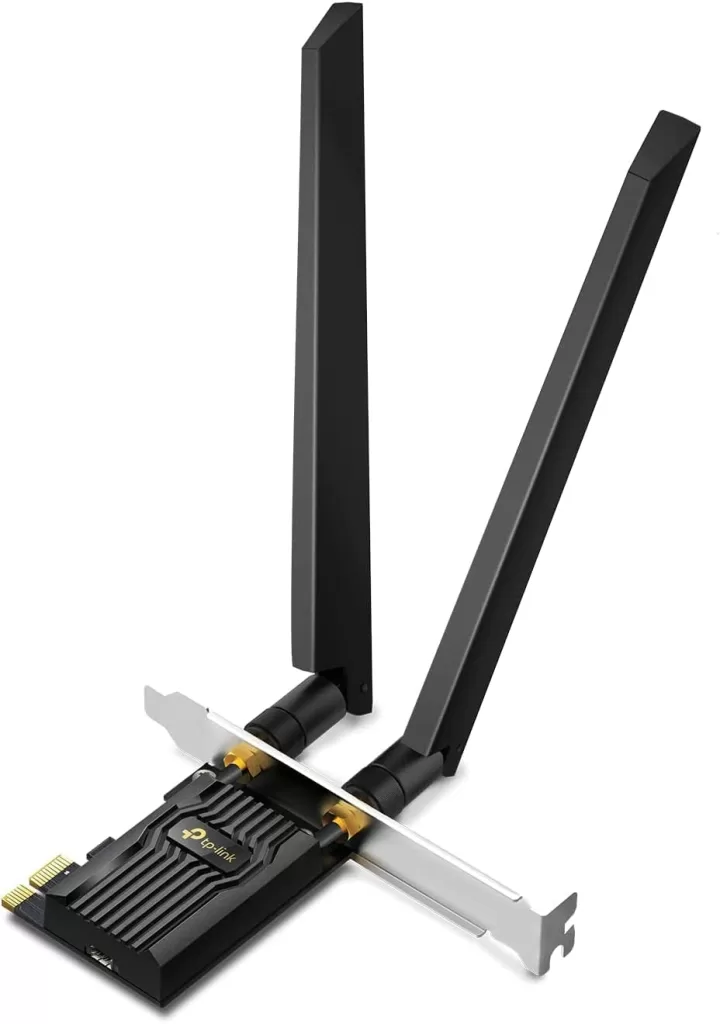Last updated on February 12th, 2025 at 01:28 pm
If you’re having issues with slow internet speed when you know your internet is fast, or your Wi-Fi keeps disconnecting randomly, you probably need to buy either a USB or a PCI-E Wi-Fi adapter.
Before you decide to buy one, you’re going to need to see if either USB or PCI-e is the better option for your next Wi-Fi adapter. Let’s look at PCI-e Wi-Fi cards vs. USB adapters and the pros and cons of each.
PCIe: Stronger Reception, But More Inconvenient
PCI-e wireless adapters provide a lot of network power. They usually have two or more antennae, which helps increase your Wi-Fi reception. High-end PCI-e network adapters usually support MIMO antenna technology, which in layman’s terms reduces network errors and improves your Wi-Fi connectivity.
A PCI-e Wi-Fi network adapter goes into the PCI Express port in your motherboard. These network adapters are primarily for desktop PCs, which usually don’t include built-in Wi-Fi like a laptop.
If you built your PC, you shouldn’t have any trouble finding this port. It’s located near where your GPU is plugged in. But if you haven’t, it can be a bit challenging to find out where the port was placed.
So, does this mean that a PCI-e wireless adapter is likely going to work better than USB Wi-Fi adapters? On paper, yes, but it might not always be the best choice.
First, once you install it on your motherboard, it’s not easy to remove it and use it on another desktop PC. Many people find that placing the antenna between your computer case and the wall can badly restrict the amount of signal reception your PCI-e wireless adapter is capable of.
Even though the antennae on PCI-e might be more powerful, putting metal between them and your Wi-Fi signal’s source can severely degrade performance, which can lead to slow network speeds. And for some people, having antennas sticking out of the back of their computers doesn’t look aesthetically pleasing.
Because PCI-e wireless adapters plug directly into your desktop PC, it can result in stronger signal strength and faster Wi-Fi transmission. Some PCI-e wireless adapters also include Bluetooth capability, so you don’t have to buy a separate Bluetooth adapter.
USB: More Convenient, But Weaker Signal
In contrast, a USB Wi-Fi network adapter is way easier to set up: you just plug it into a USB port on your computer and connect your device to a Wi-Fi network. You might need to install some drivers, but otherwise else that’s it.
And that’s simply what makes using a USB Wi-Fi adapter more convenient compared to a PCI-e wireless adapter.
It’s not difficult to use, you can transfer it to a new computer effortlessly, and it’s so easy to set up that it’s almost impossible to have any issues with the installation.
The adapter barely takes up space and can be used on both desktops and laptops, while a PCI-e wireless adapter is usually restricted to desktop use only.
Because most USB wireless adapters don’t use any external antennae, this means that they’re typically less powerful than PCI-e adapters.
They likely won’t get as strong reception compared to other PCI-e wireless adapters, and many people mention that they also see lower network speeds when they use USB adapters.
Despite this, some people find they get very good speeds with USB wireless adapters. It likely depends on the quality of the USB adapter and the locations of the router and computer.
If you buy a high-quality USB adapter that’s capable of 802.11n, 802.11ac, or 802.11ax transmission and has a clear line between the adapter and the router, you may get very respectable Wi-Fi speeds.
Back in the day, the bandwidth of USB ports used to be a limiting factor. With USB 3.0, however—which has become nearly universal—that’s no longer an issue.
What’s The Difference Between PCIe Wi-Fi Cards and USB Wi-Fi Adapters?
Here’s a table summarizing the key differences:
| PCIe Wi-Fi Card | USB Wi-Fi Adapter | |
| Performance | Generally better | Can be lower |
| Range | Often better | Can be shorter |
| Installation | More difficult | Easy to install |
| Portability | Less portable | Highly portable |
| Price | Generally more expensive | Generally more affordable |
PCIe vs. USB Wi-Fi Adapters: Which Is Better?
Now that you’ve seen a few of the pros and cons that these adapters have, you can make a better decision about which one will be better for you.
If you’re using a desktop, you don’t plan on moving the wireless adapter between different computers, and you can position the antenna well, a PCI-e card is more likely to give you a better performance.
However, a USB wireless adapter is small, easy to install, able to be transferred between different computers seamlessly, and can get very decent speeds if it’s set up properly.
And because your router is sometimes not in the right place for maximal speed, there’s a good chance you’ll have to move things around anyway to get better results. It can be difficult to figure out which network adapter you should buy. There’s a huge range of brands, models, and prices, but there are a few things that are good to remember.
For either PCI-e or USB adapters, choose one that is at least dual-band capable. It is very good to have the option to use 2.4GHz or 5.0GHz when searching for the best reception. 2.4GHz, while slower, is stronger and will be able to penetrate walls and other obstacles more easily.
While most PCI-e adapters are dual-band, not all USB adapters are. If you decide to go with a network card, choose one that has at least three antennae for optimal performance.
Along with dual-band capability and more antennae, your best bet is to look for a wireless solution from a reputable company that can handle the wireless standard of your router.
Conclusion
In summary, the decision to choose between USB and PCI-e wireless adapters is a toss-up.
If you’re looking for convenience and ease of use, a USB Wi-Fi adapter is the way to go. However, if you need stronger reception, and faster transmission, and are willing to put up with some installation challenges, a PCI-e wireless adapter might be the better choice.
There is no right or wrong answer, as both of their pros and cons make them pretty much even in comparison.
Whether you decide on a USB or a PCI-e Wi-Fi adapter, choosing the right wireless network adapter is important to having a seamless digital experience. As long as you stick to reputable brands, you should have no issues with your Wi-Fi connection.
Best USB Wi-Fi Adapter – NETGEAR Nighthawk A8000
If you want to easily upgrade your PC to faster Wi-Fi speeds, the NETGEAR Nighthawk A8000 is the best USB Wi-Fi adapter you can buy. With a simple plug-and-play design, you can quickly add Wi-Fi 6 and Wi-Fi 6E, no matter how old your PC is. It has a compact design, which means you will have no issues plugging it into your laptop.
With up to 3Gbps of Wi-Fi speed, you will be able to do gaming, video conferencing, and streaming with ease. If you want a Wi-Fi adapter that offers blazing-fast Wi-Fi performance on any desktop or laptop without difficult installation, the NETGEAR Nighthawk A8000 is an excellent choice.
Best PCIe Wi-Fi 7 Card – ASUS PCE-BE92BT

Are you struggling with slow Wi-Fi speeds, or just want to have the fastest network connection possible without using Ethernet cables? Look no further than the ASUS PCE-BE92BT. With cutting-edge Wi-Fi 7 support (Windows 11 only), you will be able to experience tri-band speeds up to 5 GHz. With Multi-RU technology, your desktop PC will have superior networking stability, regardless of how much office tasks, streaming, or gaming you do.
It also comes with Bluetooth 5.4 support, which means you will able to have a more reliable and stronger Bluetooth connection with your favorite wireless devices. If you need state-of-the-art wireless speeds, along with reliable performance, the ASUS PCE-BE92BT is the best PCIe Wi-Fi 7 adapter you can buy.
Best PCIe Wi-Fi 6 Card – TP-Link Archer TXE72E

If you have a desktop PC without any Wi-Fi support, the TP-Link Archer TXE72E is a great choice for many users. This PCIe wireless card supports Wi-Fi 6 & 6E, which means that your desktop will have fast Wi-Fi performance and reliability compared to other PCs with Wi-Fi 5 adapters. With OFDMA and MU-MIMO technology, your desktop PC will have low latency and better network stability, making it suitable for online gaming and video conferencing.
This PCIe card comes with Bluetooth 5.2 support, which has 2X faster transmit speeds and a 4X wider range compared to the older Bluetooth 4.2. If you want to cut the Ethernet cord and enjoy speedy wireless connections on your desktop PC, the TP-Link Archer TXE72E is highly recommended.









